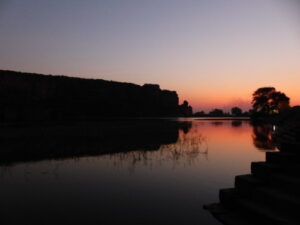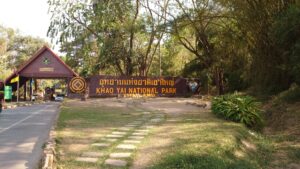must see in Mahārāshtra and Karnataka provinces
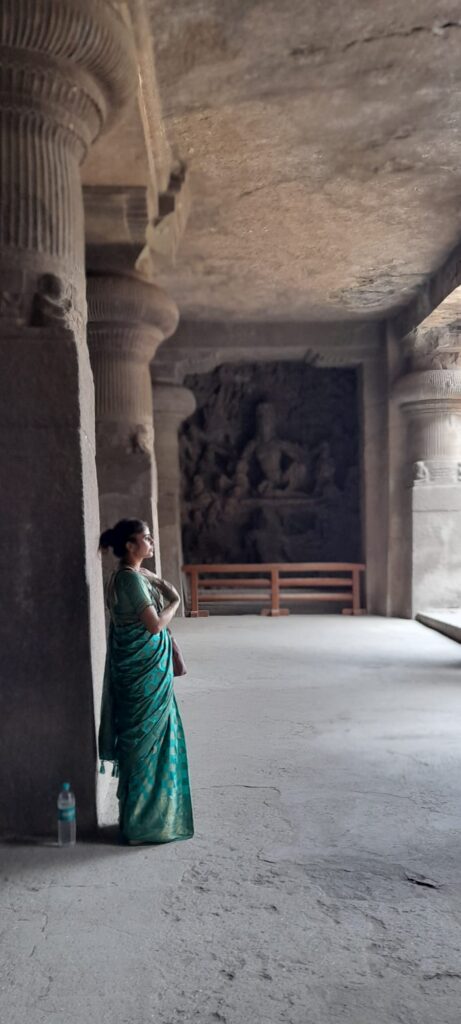
India for many is the Taj Mahal, its most iconic image. But we will introduce you to other amazing monuments much less known, although just as ashtonishing and dazzling as it: the many cave temples carved throughout the country, among which, in our opinion, most of them, and the most beautiful are in the state of Mahārāshtra (Elephanta, Nasik, Aurangabad, Ellora and Ajanta) but Badami is in Karnataka. All of them are protected monuments, and some are UNESCO World Heritage Centres (Elephanta, Ellora and Ajanta: https://whc.unesco.org/; Elephanta Caves – UNESCO World Heritage Centre; Ellora Caves – UNESCO World Heritage Centre; Ajanta Caves – UNESCO World Heritage Centre –WHC-).

Most of them are carved out of hard basalt rock, with the exception of the Badami cave temples, which are located in clifs of very red sandstone. In all of them “viharas” abound, monasteries-residences that include sleeping cells in many cases, for the Buddhist, Hindu or Jain monks, and were also places to meet and listen to sermons (https://en.wikipedia.org/wiki/Vih%C4%81ra), and some are “chaityas”, Hindu, Buddhist or Jain temples or shrines used for chanting and meditation.
The UNESCO WHCs have much higher ticket prices than the others, usually double. In both, foreign citizens pay more than twelve times the price of Indian citizens.
The standard price is Rs 300 per person for foreign citizens and Rs 25 for Indian citizens. In the UNESCO World Heritage Centres the entrance fee is Rs 600 for foreigners and Rs 40 for Indian citizens. Normally, tickets are available at the ticket offices located at the entrance to the venues.

This sites can be crowded on weekends and national holidays, so we recommend scheduling visits on a week day, if posible, specially the Ellora and Ajanta Caves, one of the major tourist attractions of Mahārāshtra.
We have already proposed a trip that include these monuments, starting in Mumbai
We wil briefly explain what is most interesting about each place, but we also recommend the Lonely Planet travel guide. We added links to the Wikipedia pages of each site for those who want to dig a bit deeper into art and other very detailed descriptions (see links for more information).
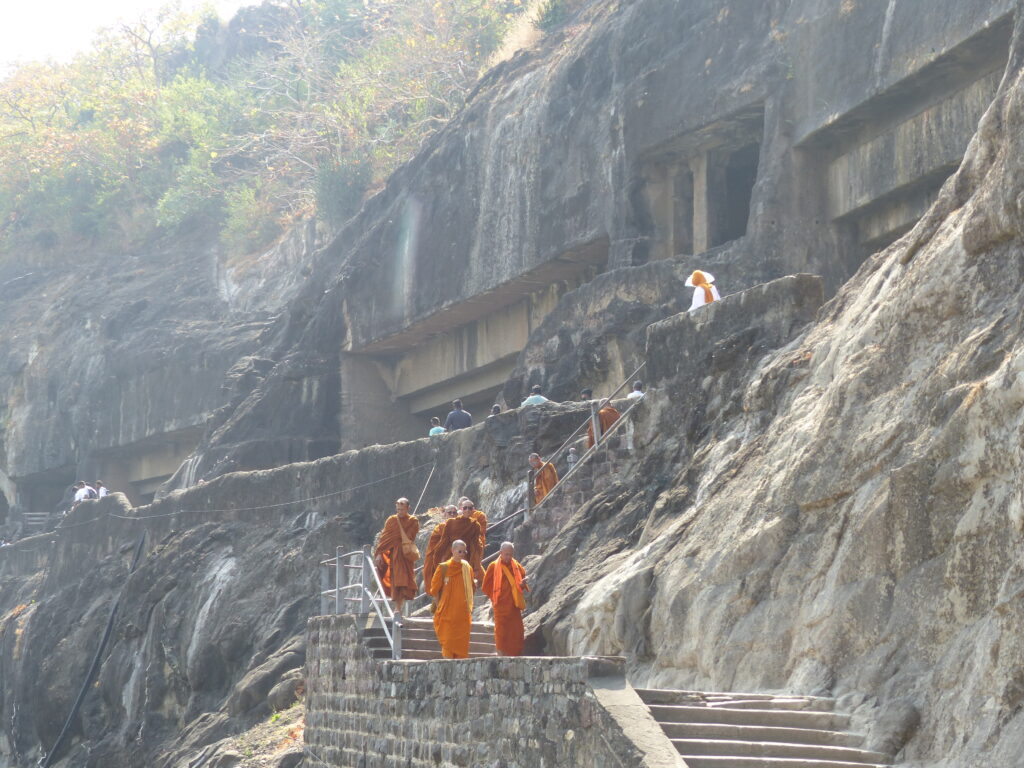
If you have a very short schedule, it is better to visit just the Elephanta Caves, for its proximity and easy access from Mumbai. But for those interested in Hindu, Jain and Buddhist art, history and religion, and keen to escape the beaten path, visits of Ellora and Ajanta are a must, but can skip the Elephanta Caves, as only Cave 1 has magnificient sculptures. To complete the whole trip is a very good option for the few with time and a taste for slow travel and etnographic inmersión. It is worth the effort!
We took different means of transportation to reach the sites: Elephanta caves by boat, Nasik caves by rickshaw, Aurangabad caves by foot, Ellora caves by taxi, Ajanta caves by public bus and Badami caves again by foot!
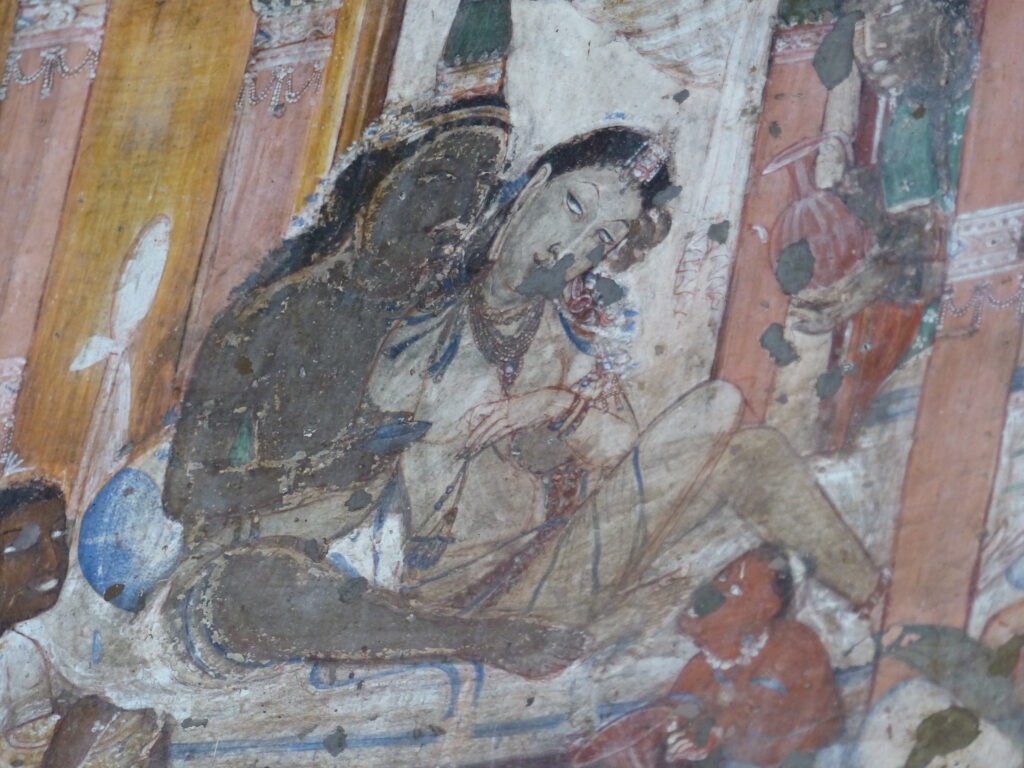
Elephanta caves
The colonial Portuguese named it Ilha Elefante, which became Elephanta, because they found elephant statues in the caves. They established a base on the island of Elephanta, or Gharapuri (literally, «the city of caves”), which is 10 kilometres east of Mumbai. The boat trip takes 45 minutes and it is a relaxed opportunity to visit the port of Mumbai.

The larger group of caves consists of five caves on the western hill of the island and is well known for its Hindu sculptures, predominantly dedicated to Lord Shiva. There are also a few Buddhist stupa mounds and two Buddhist caves. They are most commonly placed between the 5th and 7th centuries, although many scholars consider them to have been completed around 550 CE.
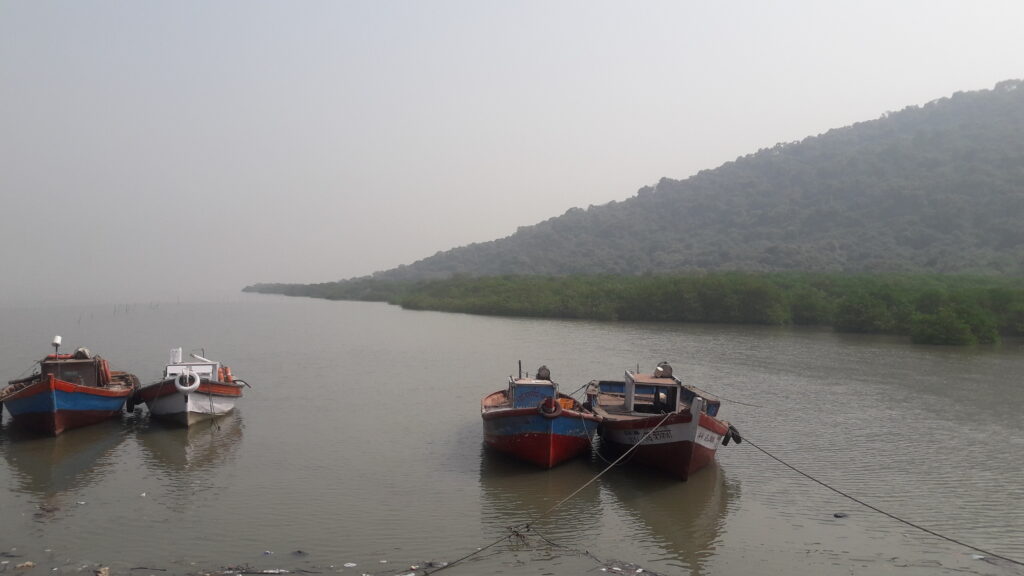
The main cave (Cave 1, or the Great Cave) was a place of Hindu worship until the Portuguese arrived. The monuments were restored in the 1970s. In 1987 were designated a UNESCO World Heritage Site, currently maintained by the Archaeological Survey of India (ASI). Many artworks from the Elephanta Caves are now in major museums in India.
Nasik caves
The Nasik caves or Trirashmi Leni (caves of the Trirashmi Hills, in Marathi language) are a group of 23 caves, located about 8 km south of the center of Nasik, facing east. These caves are some of the oldest in Mahārāshtra. They were carved between the 1st century BCE and the 3rd century CE, as attested by the inscriptions recording donations, and represent the tradition of Early Buddhist school: The inscriptions confirm that apart from the kings, local merchants and landowners also supported and donated large sums for the development of these caves.

There are water tanks near some cave entrances.
Most of the caves are viharas except for Cave 18 which is a chaitya of the 1st century BCE, made during the Sunga dynasty. Some of the caves are very small and poorly decorated, but some other are large and contain numerous chambers, as well as interesting sculptures. The most beautiful viharas are Caves No 3 and 10, and chaitya No 18, with an impressive carved Stupa.
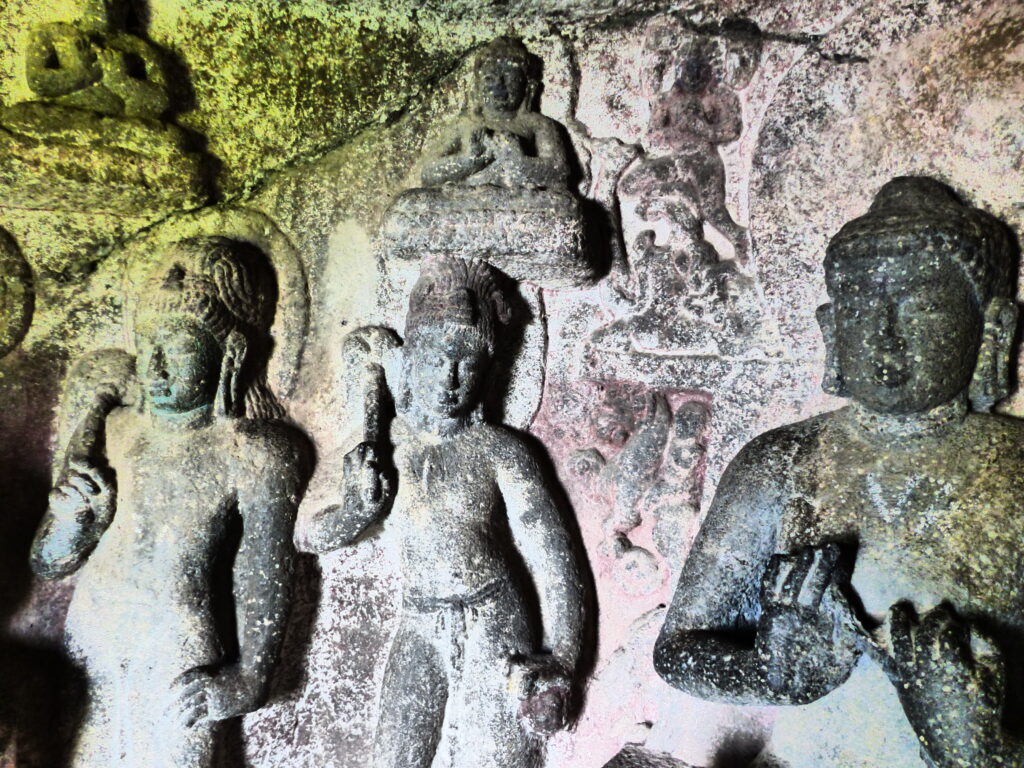
We went there on a battery-powered, three-wheeled rickshaw.
Aurangabad caves
The Aurangabad caves are twelve rock-cut Buddhist shrines located on a hill running roughly east-west, 9 kilometers from the city of Aurangabad, Mahārāshtra. The first reference to the Aurangabad Caves is found in the great chaitya of Kanheri caves. The Aurangabad Caves were carved out of comparatively soft basalt rock during the 6th and 7th centuries.

The caves are divided into three separate groups: the «Western Group», with Caves I to V, the «Eastern Group», with Caves VI to IX, and a «Northern Cluster», with the Caves X to XII unfinished.
We walked there, through the modern campus of Dr Babasaheb Ambedkar Marathwada University, and came back to the back side of the Bibi-ka-Maqbara.

Although their carvings are comparable to Ajanta and Ellora, and a supposed missing link between the two for some 20th-century scholars, the caves are much smaller, more decrepit and less visited. In any case, they are also interesting and a good preliminary to visit the most famous.
Ellora Caves
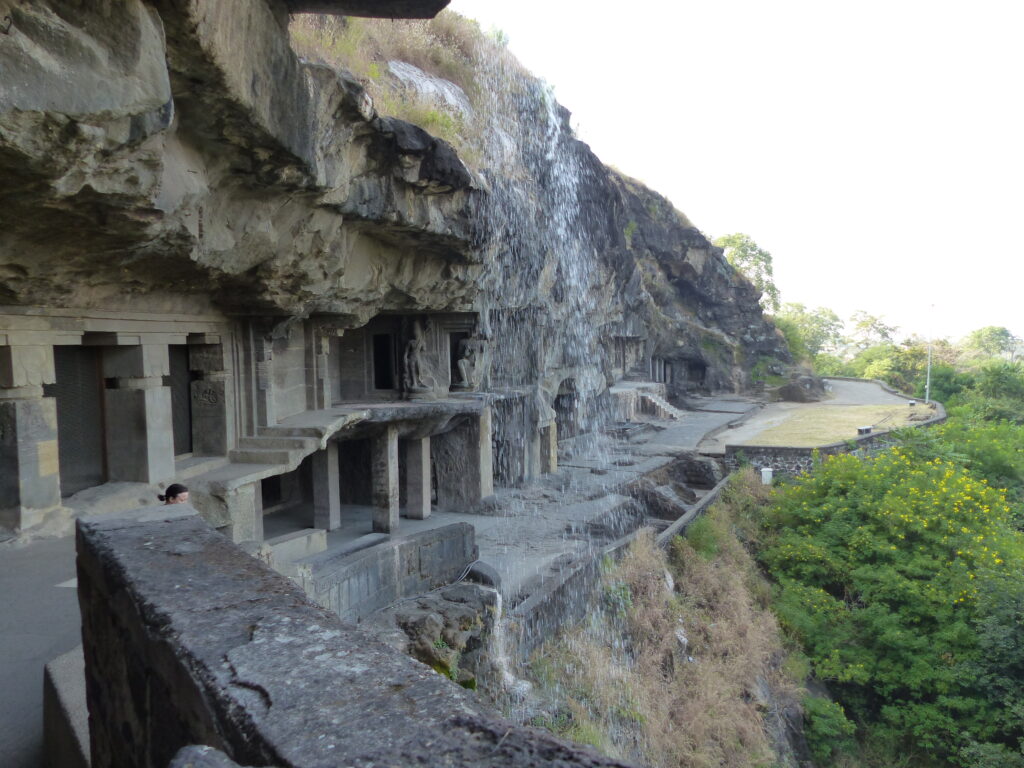
Ellora is a UNESCO World Heritage Site located also in the Aurangabad district, in the Marathwada region of state of Mahārāshtra, about 29 kilometres northwest of the city of Aurangabad and about 300 kilometres east-northeast of Mumbai. Ellora occupies a relatively flat rocky region of basalt clifts in the Charanandri Hills belonging to the Western Ghats. There are some delicate waterfalls that give the surrondings a fairy tale look. It is one of the largest rock-cut Hindu temple cave complexes in the world, with Hindu artwork dating from mid-6th to late 8th century CE; Buddhist caves were built between 630 and 730 CE, and Jain cave work probably began in the late 8th century, with construction and excavation activity extending beyond the 10th century and into the 13th century. Its location on an ancient South Asian trade route also made it a major trade center in the Deccan region.
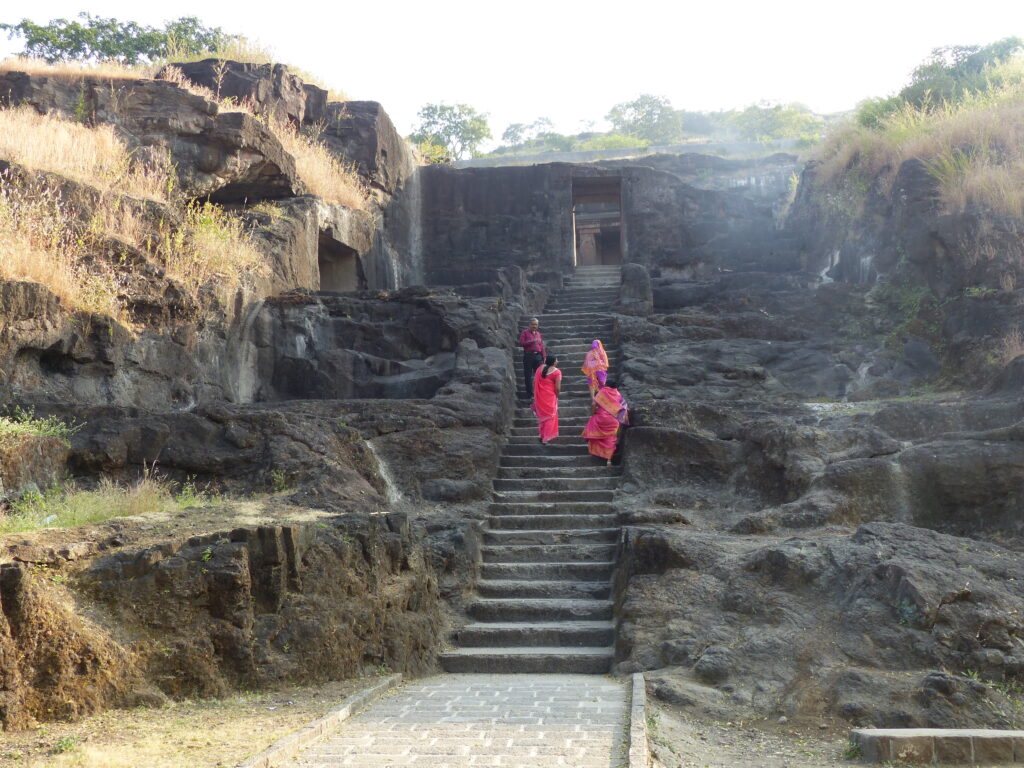
There are over 100 caves at the site, 34 of which are open to the public: 17 Hindu caves (13–29), 12 Buddhist caves (1–12) and 5 Jain caves (30–34). They were built close to each other and illustrate the religious harmony that existed in ancient India. All the monuments at Ellora were built during the Rashtrakuta dynasty (c. 753-982 CE), which built part of the Hindu and Buddhist caves, and the Yadava dynasty (c. 1187–1317), which built most of the Jain caves. Funding for the construction of the monuments was provided by royalty, traders and the wealthy of the region.

The most outstanding Hindu caves, which you cannot miss, are numbers 29, 21 and 15. Other notable Hindu caves are the Ravan ki Khai (Cave 14) and the Nilkantha (Cave 22), both of which house numerous sculptures. Cave 25 in particular features a carving of Surya in its ceiling.
The cave that stands out in Ellora in fact is a carved temple, cave 16. It features the largest single monolithic rock excavation in the world, the Kailash temple, a chariot-shaped monument dedicated to the god Shiva, as well as sculptures depicting various Hindu deities and relief panels that summarize the two major Hindu epics: the Ramayana and the Mahabharata.

Caves 5, 10, 11 and 12 are the most architecturally important Buddhist caves. Notable among them is Cave 10, a chaitya worship hall called the ‘Vishvakarma cave’, built around 650 CE. It is also known as the «Carpenter’s Cave», as the carvings appear to be made of wood.
Among the Jain caves, cave 30 is known as Chhota Kailash, or the little Kailasha, as it resembles the structure of the Kailash temple. Cave 32 is also noteworthy, as it includes fine carvings of lotus flowers and other elaborate ornaments.

Ajanta Caves
The Ajanta Caves are approximately thirty rock-cut Buddhist cave monuments dating from the 2nd century BCE to about 480 CE (the mid-5th century), although most of the work took place over the very brief period from 460 to 480 CE 480 CE, during the reign of king Harishena. The Ajanta Caves are generally agreed to have been made in two distinct phases, the first during the 2nd century BCE to 1st century CE, and a second several centuries later. The numbering of the caves is a convenience convention, and does not reflect the chronological order of their construction. The caves are located in the northern rock face of the U-shaped gorge of the Waghur River on the Deccan Plateau. Within the gorge are a series of waterfalls.
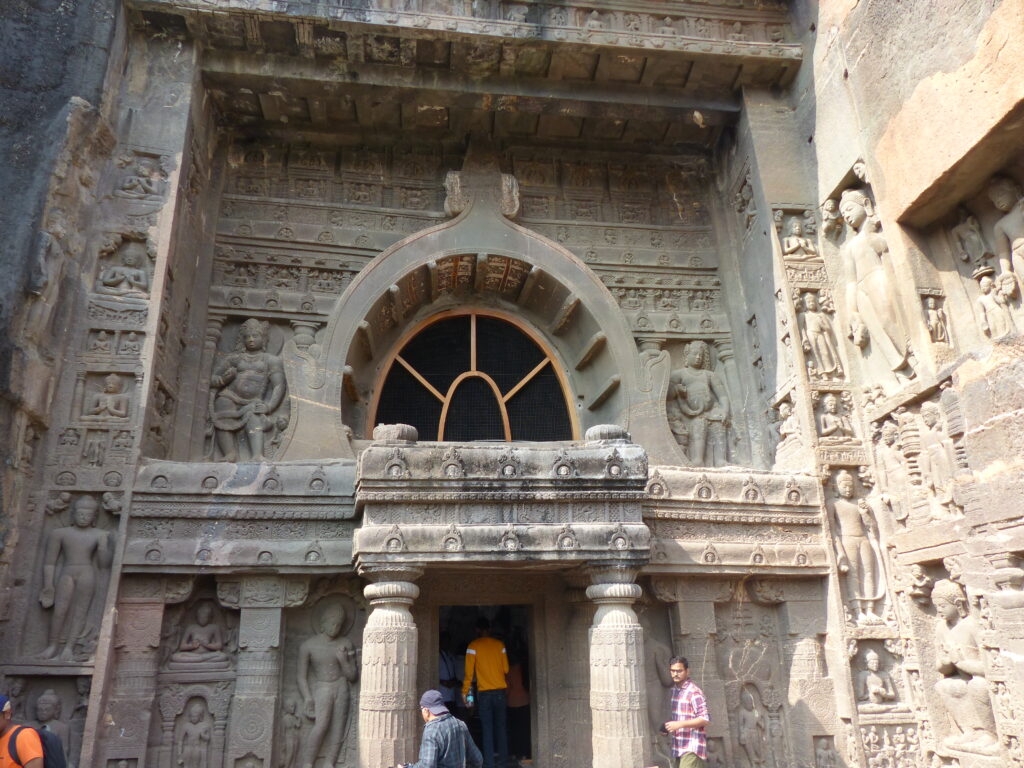
Ajanta caves are located in the Aurangabad district of the state of Mahārāshtra, about 105 kilometres from the state capital and 59 kilometres from the city of Jalgaon. Ajanta is 100 kilometres from the Ellora Caves, which is home to Buddhist caves dating from a similar period to Ajanta. They were covered by jungle until accidentally «discovered» and brought to the attention of the West in 1819 by a Brittish colonial officer, Captain John Smith, on a tiger hunting party.
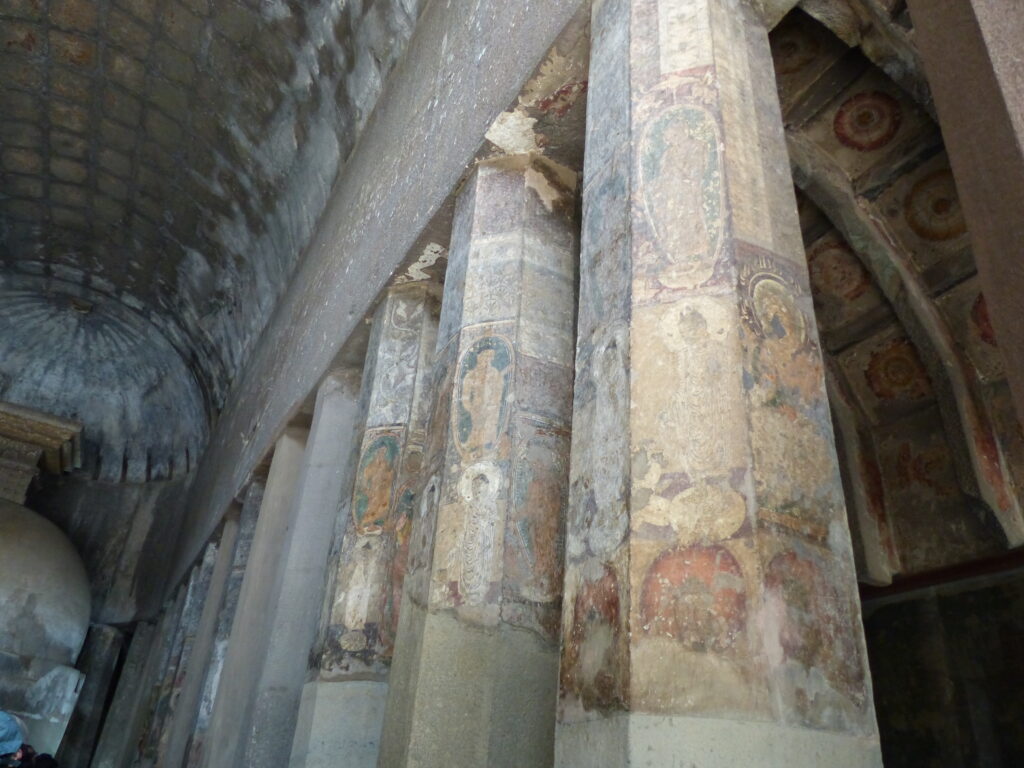
The site is a protected monument under the care of the Archaeological Survey of India, and since 1983, the Ajanta Caves have been a UNESCO World Heritage Site.
Textual records suggest that these caves served as a monsoon retreat for monks, as well as a resting site for merchants and pilgrims in ancient India.

The caves include vividly colored wall paintings and rock-cut sculptures described as some of the best surviving examples of ancient Indian art: particularly expressive paintings that present emotion through gestures, poses and forms, universally regarded as masterpieces of Buddhist religious art.
The earliest group consists of caves 9, 10, 12, 13 and 15A. The murals in these caves depict stories from the Jatakas. Later caves reflect the artistic influence of the Gupta period, but there are differing opinions on which century in which the early caves were built. Caves 9 and 10 are stupa containing worship halls of chaitya-griha form, and caves 12, 13, and 15A are vihāras. The early caves of the Satavahana period lacked figurative sculpture, emphasizing the stupa instead.

The second phase is attributed to the theistic Mahāyāna tradition of Buddhism. The second period caves are 1–8, 11, 14–29, some possibly extensions of earlier caves. Caves 19, 26, and 29 are chaitya-grihas, the rest are viharas. The most elaborate caves were produced in this period, which included some restoration and painting of the first caves.
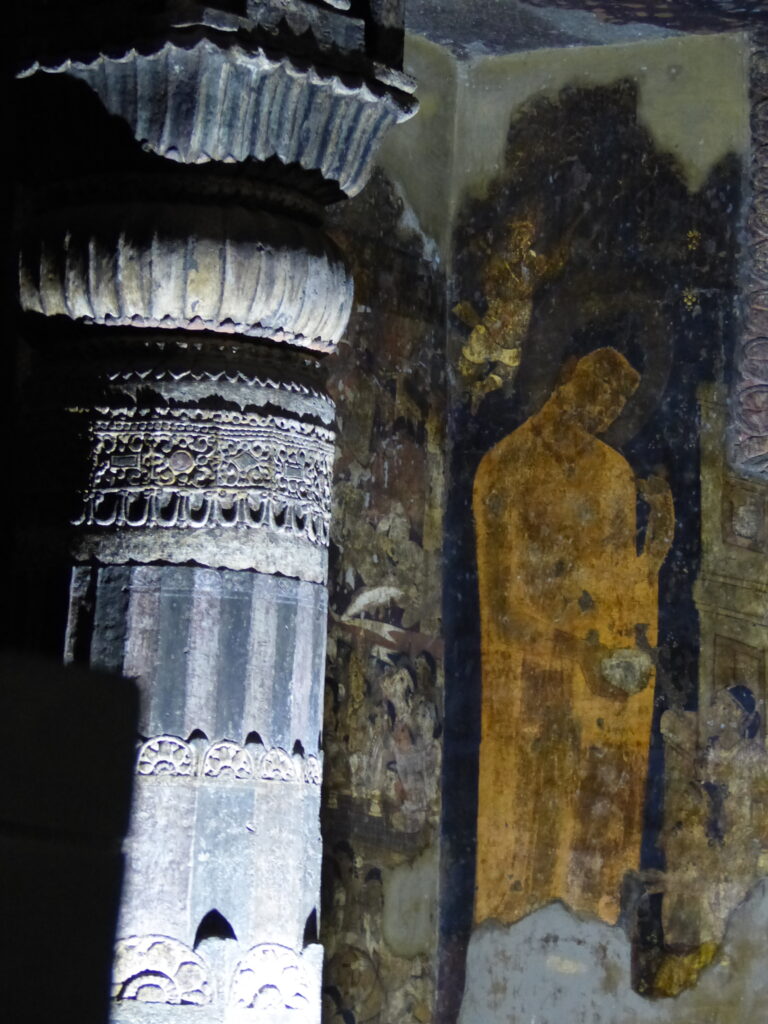
Ajanta caves 16, 17, 1 and 2 form the largest corpus of surviving ancient Indian wall-painting.
Badami cave temples
The Badami cave temples are a complex of Hindu and Jain cave temples located in the south-east of the town of Badami, in the Bagalkot district in the northern part of the state of Karnataka. The cave temples are 23 km from the UNESCO World Heritage Site Pattadakal. The Badami cave temples are carved from soft Badami sandstone into a cliff on a hill.
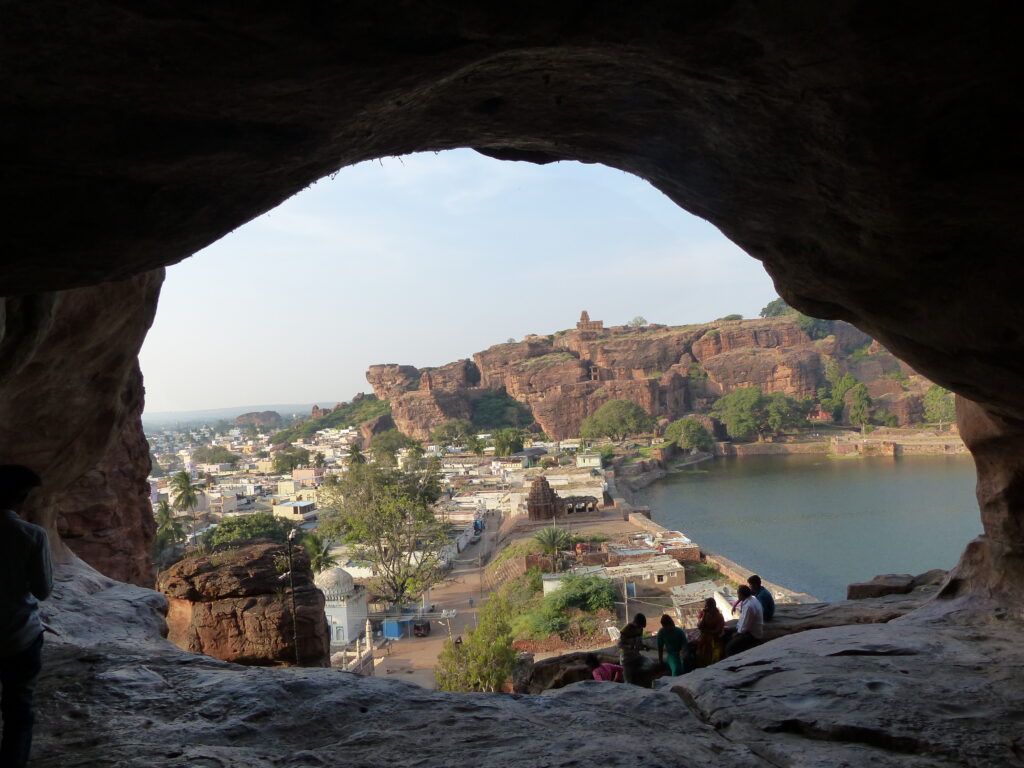
The caves are important examples of Badami Chalukya architecture, with the earliest dating back to the 6th century. Badami is a modern name and was formerly known as Vataapinagara, the capital of the early Chalukya dynasty, which ruled much of Karnataka from the 6th to the 8th century.
The Badami cave temples represent some of the earliest known examples of Hindu temples in the Deccan región. They are connected by a stepped path with intermediate terraces overlooking the town and lake. The cave temples are labelled 1–4 in their ascending series, but this numbering does not reflect the excavation sequence.

In Cave 1, a prominent Hindu carving is of Shiva dancing Tandava as Nataraja. Cave 2 is mostly similar to cave 1, highlighting the relief of Vishnu as Trivikrama. Cave 3 is the largest and most intricately carved in the complex, related to Vishnu. Cave 4 is dedicated to revered figures of Jainism. Surrounding the lake, Badami has additional caves and temples.
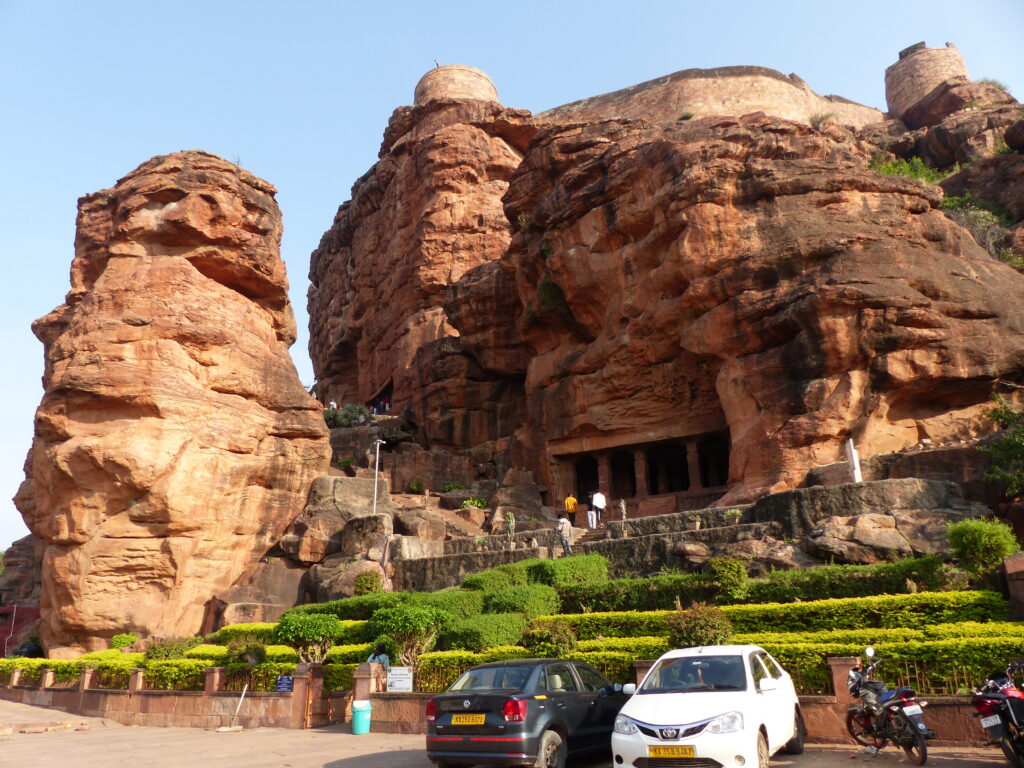
The plan of each of the four caves includes an entrance with a verandah (mukha mantapa) supported by stone columns and corbels -a distinctive feature of these caves-, leading to a columned mantapa, or main hall (maha mantapa), and then to the small square shrine (garbha ghriya) deep in the cave.


